Most padlocks, even expensive ones, provide only a very low level of security. I believe that knowing the faults in your security is a good thing, so someone who uses a lock for security should know how to defeat that lock, or at least be aware of the ways the lock can be defeated, so they can better design their security. In addition, knowing how to easily open a padlock might in certain circumstances prove useful. I have a coworker who routinely forgets the combination to the padlock she uses on her locker. She does keep the combination written down, but the last time she forgot her purse was already locked in her locker, which put it rather inconveniently out of reach. I get to play hero and get her stuff out of her locker, without her having to call maintenance and get the lock cut off. Locks only keep honest men out, and honest men don't need keeping out.
Standard disclaimer: This project and others available on this site uses heat, tools, chemicals, and open flames. You are responsible for taking all applicable safety precautions, and applying common sense. Since I have no control over how you do things in your own shop, or what precautions you choose to use or not use, and I'm not there to hold your hand, it's not my fault if you hurt yourself. For this project, an additional disclaimer is that lock shims might be considered burglary tools in your local area, and if you're caught with such things on your person, might result in legal troubles. In my area, calling something a burglary tool requires showing intent, but some things, such as lock shims, have only one real purpose, where a crowbar or hacksaw has many. For your own protection if you intend to learn how to open locks without keys, you might consider joining an organization for 'locksport', which is the hobby of locksmithing and lockpicking, or otherwise documenting your legitimate interest in how locks work. Picking locks is not a crime. Having tools to pick locks is not a crime. Picking locks that don't belong to you, for dishonest purposes is. The distinction is going to be lost on your average police grunt. The safest and most ethical course is to only pick locks that you personally own, or which the legitimate owner has given you permission to pick. That will save you a lot of trouble in the long term.
This one doesn't take much. I don't bother carrying lock shims around. I just find a soda can and make one when I need one. If you don't have them on your person, you can't get in trouble for having them on your person, and its a matter of a few moments to make one.
Scissors, a straight edge if you want to be especially neat about it, a marker if you like to mark your cuts. The tolerances are not very critical, and the key is not to follow a specific measurement as much as to practice this and get a feeling for how the piece is shaped and how it interacts with the lock. When I'm making one of these to use I don't bother measuring or using a straight edge.
First you need to understand what's going on inside the lock, and why that gives it exploitable weaknesses. This demo only applies to padlocks of average to cheap construction. Plenty of folks use these to secure lockers, lock up sheds, chain bikes, etc. Unfortunately such locks give only an illusion of security. Your average cheap combination lock has several ways it can be opened, in addition to knowing the combination. In this demo, I'll be showing you how to defeat the lock without needing to move the dial at all. The weakness we'll be exploiting is twofold. First, for convenience the lock is designed to lock when the shackle is pushed closed. It has a spring loaded pawl that engages a notch in the shackle. Because the pawl is spring loaded, it can be pushed back by the shackle, then ride forward again as the notch in the shackle passes it, securing the hasp. This is a weakness because the pawl is designed to be pushed back, and the lock does not have to be in an unlocked configuration for it to do so. If it was designed with better security, you'd have to keep the lock in an unlocked configuration, hold the shackle closed, and spin the dial to lock it. That's too much inconvenience for the average customer, so they build locks with a spring between the locking mechanism and the pawl. Second, the shackle isn't a perfect fit in the lock shell; it's just slightly undersized for the hole. If it was exactly the same size as the hole it would have to be perfectly lined up for it to go in and that would make the lock a bit trickier to lock. Again this is too much trouble for the average customer, who cares more about convenience than security. The loose fit of the shackle in the lock shell means that there's a gap between them. It's not a large gap, but it's there. Tools can be inserted, as long as they're made from something very thin and very strong. Soda can aluminum is very thin and very strong...

Here's all the materials in place. I don't know the combination to this lock. It belongs to my wife and it's been kicking around the basement for ages. I think she might remember, but it's doubtful. That makes it perfect for this demo.

Here's a rough schematic of what's going on inside the lock. For shimming, this is all you need to know, so I haven't even bothered to draw the actual lock mechanism. We won't be playing with the dial, figuring out the combination, or doing any of the things that your average person might think of to open it; we're just going to push the pawl back.
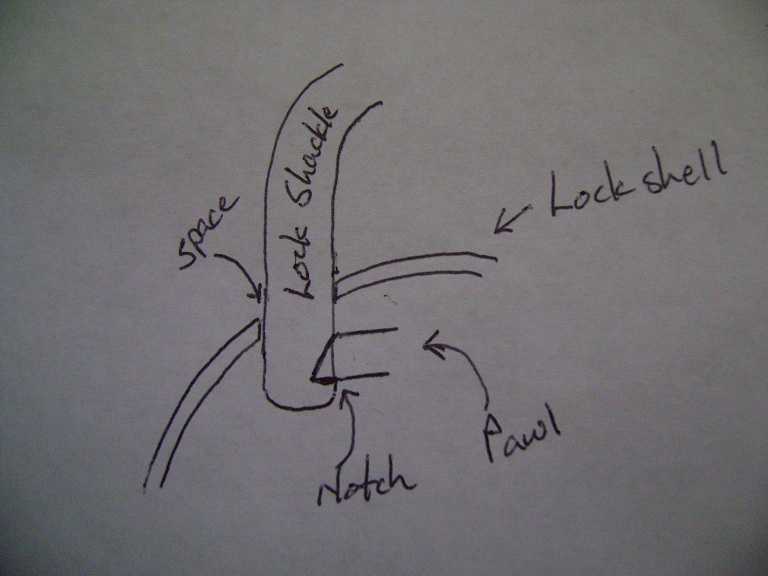
In order to push the pawl back, we need a tool with a wedge shape. The end of our shim needs to be cut to a blunt point to push against the pawl as its inserted, it needs to be long enough to reach the pawl, and it needs to be curved so that it can enter the curved gap around the shackle. The shape that works here is like an enlongated knight's kite shield.
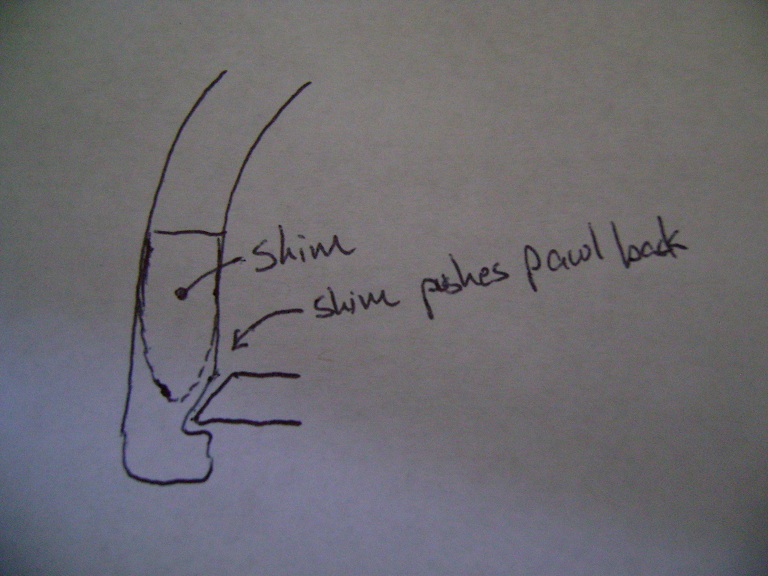
One the pawl has been pushed back, it helps if the shim can be turned to block the pawl and hold it out of the notch in the shackle while the shackle is pulled out. In order to turn it it'll need handles. That gives us our final shape for the shim. It's a knight's kite shield with elongated ears so that it can be pulled around the shackle to block the pawl.

Ok, let's cut it out. The ears need to be long enough to grip, so each one will need to be about three centimeters long. The shield shape will need to go down at least a centimeter into the lock, so that gives you its dimensions. You can use a straight edge and a marker to lay it out on your metal, or just cut by eye once you've got a good picture in your head of what you'll be making.
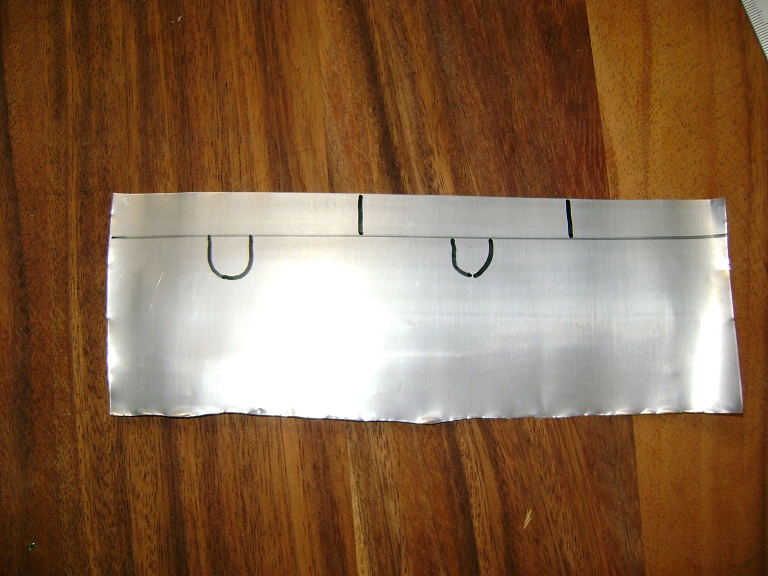
Here it is cut out. I marked and cut two, and I could have made more if I'd wanted but as I mentioned above this isn't something you want to make and carry lots of. Not only isn't it necessary since you can make one in moments, but it'll be taken to be a burglar's tool if you get caught with it.
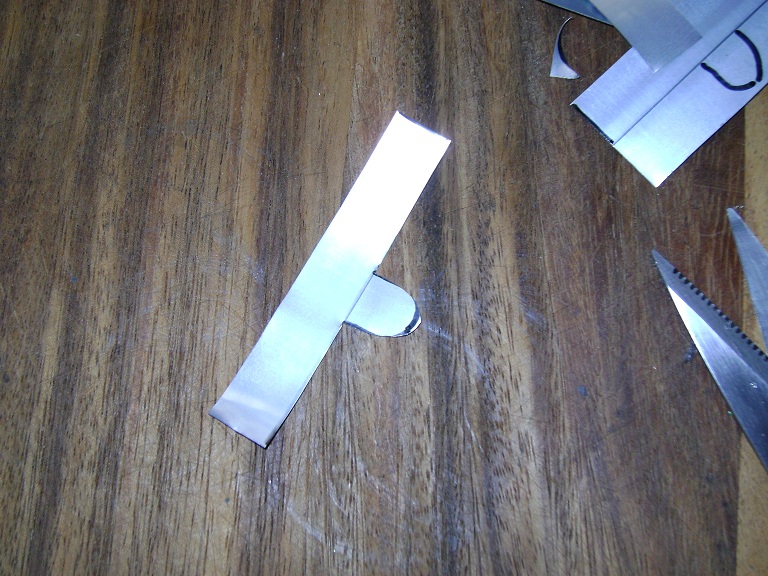
Put the shim through the shackle and begin to curve it around the shackle so that it'll go through the curved gap between the shackle and the shell.
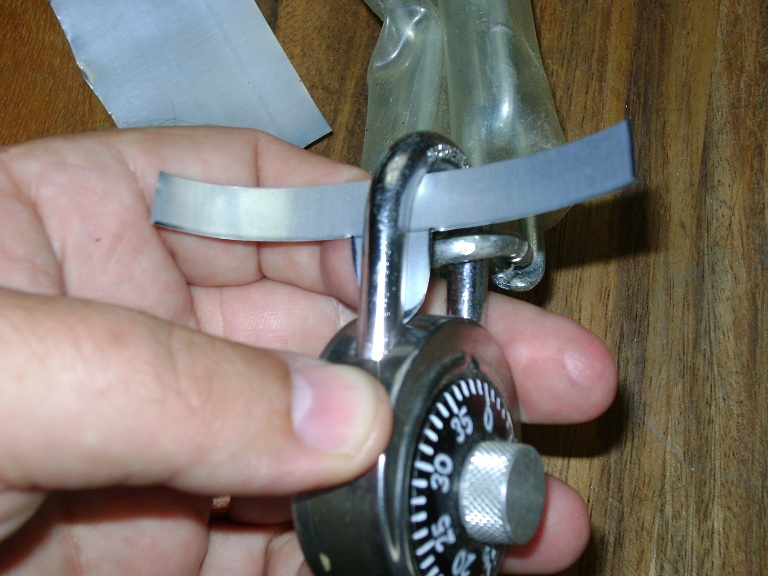
As you curve the shim, work it down the side of the shackle between the shackle and the shell. You'll feel it engage the pawl and begin to push it back. Once the shim is as far down as it can go, use the ears to rotate the shim into place between the shackle and the pawl. Then you can pull the shackle out.
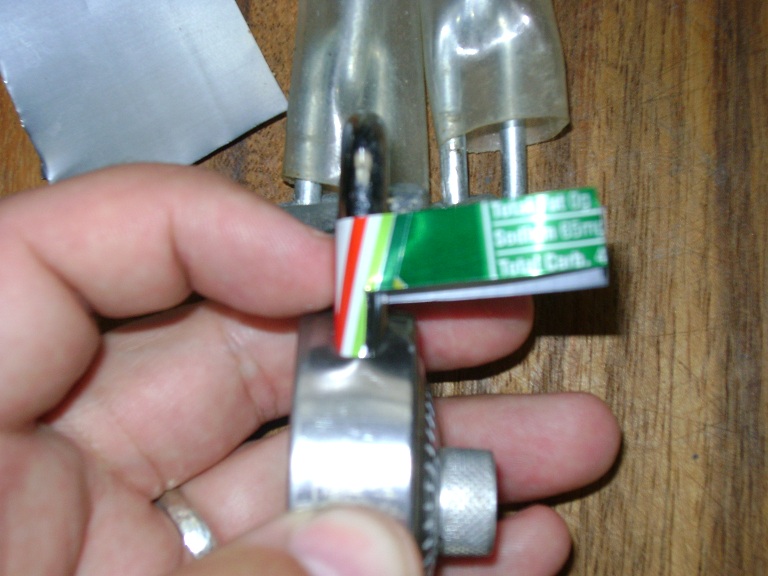
All the action happens inside the lock, out of view. Once the lock is opened, you can examine the shim and shackle in relation to each other. If you visualize the pawl engaging into the notch, you can see how the shim pushes it back.
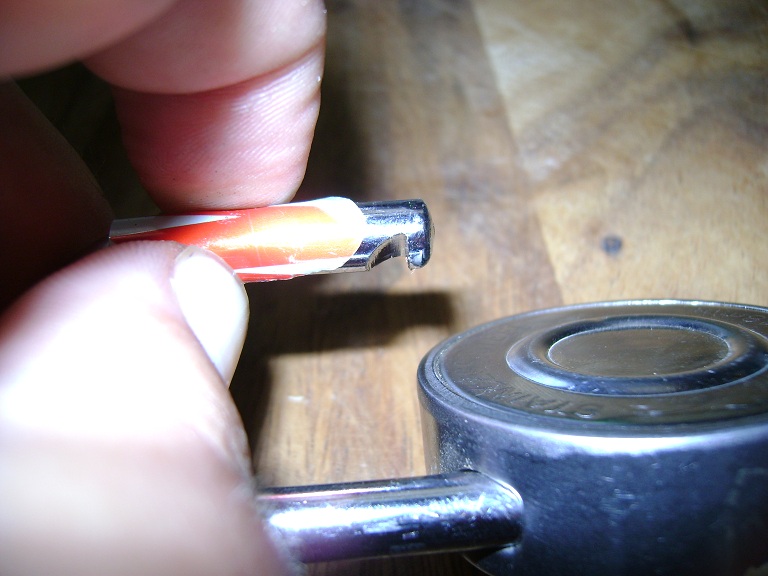
This is a useful skill on several levels. Someday you might have a legitimate need to open a padlock you don't have the combination to. In the meantime, it helps to understand how locks give the illusion of security, without any actual security. In the locksmithing industry, locks are thought of as giving a certain amount of time worth of protection. Given enough time they can be defeated. The amount of security given by a cheap padlock is seconds to minutes. Even if someone didn't want to use a nondestructive entry technique like this, they could easily cut it off with a hacksaw or bolt cutters. Even a hammer would eventually break a cheap lock.
Find more Tinker Projects: